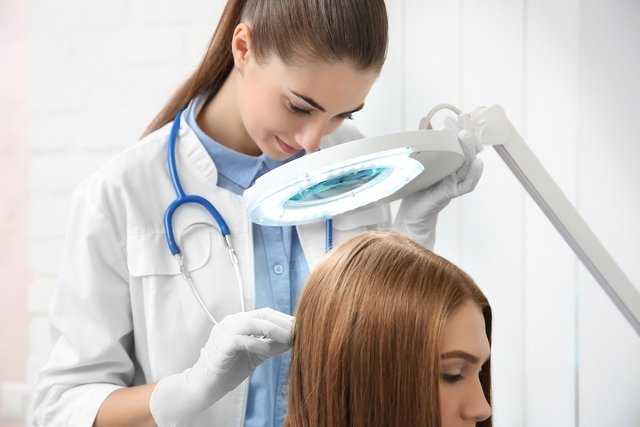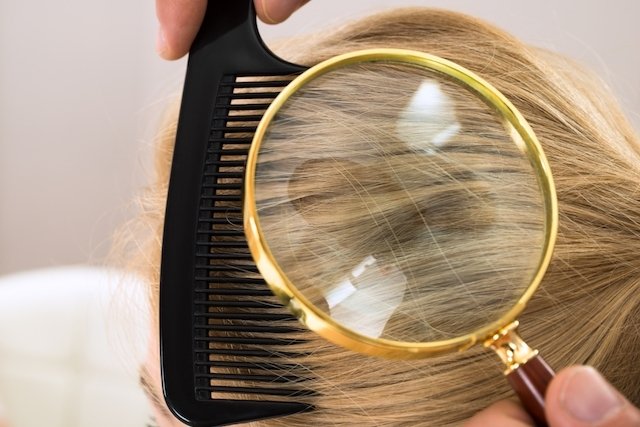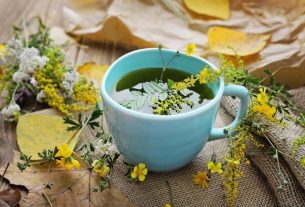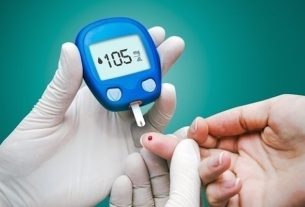Pediculosis is an infestation with lice, which can occur on the head, body or pubic area, causing intense itching, redness or even wounds due to scratching.
Lice are a parasite that does not fly or jump but passes from one person to another through direct contact with the hair of a person with lice or through the use of brushes, combs, hats, pillows or sheets, mainly affecting children’s hair. of school age.
Pediculosis treatment is carried out by a pediatrician, dermatologist or general practitioner who may recommend the use of shampoos, lotions or even pills, which varies according to the type of pediculosis and severity of the lice infestation.

Pediculosis symptoms
The main symptoms of pediculosis are:
- Intense itching in the area;
- Small wounds in the infestation region;
- Redness and local irritation;
- Small white dots on the scalp, which are normally associated with the presence of nits;
- Inflammation in the affected region, due to the presence of louse saliva and excrement.
These symptoms can appear on the head, body or pubic area, which varies depending on the type of louse.
In the presence of symptoms of pediculosis, you should consult your pediatrician, general practitioner or dermatologist, so that the most appropriate treatment can be diagnosed and initiated.
How to confirm the diagnosis
The diagnosis of pediculosis is made by a pediatrician, general practitioner or dermatologist through evaluation of symptoms and physical examination.
Make an appointment with a dermatologist in the nearest region:
Taking care of your health has never been easier!
In addition, the doctor can perform an examination using a Wood’s lamp, which is equipment that emits UV light, in order to confirm the diagnosis, as nits can present a yellow-green fluorescence.
In some cases, the doctor may also examine the tape, placing it over the infested area to collect adult lice and view them under a microscope.
How do you catch lice
Lice do not move or jump and are transmitted from one person to another through direct contact with the skin or hair of a person with lice or through the use of brushes, combs, hats, helmets, pillows or sheets.
Furthermore, in the case of pediculosis pubis, the louse can be transmitted through sexual contact or through bedding, towels or underwear.
Once the louse is caught, this parasite feeds on the blood and lays its eggs (nits) which become attached to the hair strands.
Types of pediculosis
There are three types of pediculosis which are:
- Pediculosis of the head: affects the head and is the most common type of pediculosis, caused by the type of lice Human head louse;
- Pediculosis do corpo ou corporis: affects the skin of any part of the body, caused by the type of lice A human louse is a human;
- Pubic pediculosis or boring: affects pubic hair, caused by the type of lice Pthirus pubis
The type of pediculosis is identified by the doctor according to the symptoms and diagnostic tests.
How the treatment is carried out
The treatment of pediculosis must be carried out under the guidance of a pediatrician, general practitioner or dermatologist and varies according to the location where there is an infestation.
Thus, the following may be indicated:
1. Lice shampoos
Lice shampoos, such as deltamethrin 0.2 mg/mL, may be recommended by your doctor for all types of pediculosis.
Lice shampoo should be applied to dry or wet hair according to the manufacturer’s recommendations, gently rubbing the shampoo into the hair, body or pubic hair, leaving it to act for about 10 minutes. Repeat the application for 4 consecutive days. See how to use lice shampoo.
After applying the shampoo, it is recommended to use a fine comb to remove the lice and nits that were killed by the product.
These shampoos cause intoxication, suffocation or paralysis of the lice, but they are not very effective against nits, so it is normally recommended to repeat the treatment 7 to 10 days after the initial treatment.
2. Lice lotion
Lice lotion, generally containing 5% permethrin, may also be recommended by the doctor for the treatment of pediculosis.
This lotion should be applied to clean, dry skin, gently massaging the head, body skin, between the fingers, armpits and the external part of the genital region, for example, leaving it to act for 10 minutes. Repeat the procedure after 7 days, as advised by your doctor.
The dose of 5% permethrin lotion must be advised by the doctor as it varies according to age.
3. Antiparasitic tablet
In some cases, instead of shampoos or lotions, the doctor may recommend the use of an antiparasitic, ivermectin, in tablet form, which is normally indicated in a single dose.
Furthermore, as a way to complement the treatment, some home remedies can also be used, which can be based on vinegar, rue, cornmeal or essential oils that also help to combat lice. Learn how to prepare home remedies for lice.
Treatment for pediculosis pubis
In the case of pubic pediculosis, the doctor generally recommends using a fine-tooth comb in the area to try to remove the lice and nits, in addition to recommending the use of sprays, lotions or creams suitable for the genital region and which are effective in treating the infestation. See more details on the treatment of pubic pediculosis.
Check out more tips for treating lice infestation in the video below:

Sign up for our newsletter and stay up to date with exclusive news
that can transform your routine!
Warning: Undefined array key "title" in /home/storelat/public_html/wp-content/plugins/link-whisper-premium/templates/frontend/related-posts.php on line 12
Warning: Undefined array key "title_tag" in /home/storelat/public_html/wp-content/plugins/link-whisper-premium/templates/frontend/related-posts.php on line 13




